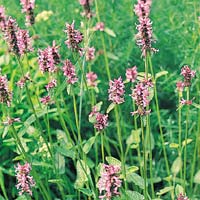Wood Betony
Uses
Parts Used & Where Grown
Native to Europe, wood betony is now planted in many parts of the world with temperate climates. The primary portions of the plant that are used as medicine are the leaves and flowers, though historically the root has also been used. There are many similar species originating from Eurasia, including Stachys sieboldii (Chinese artichoke, kan lu) and S. atherocalyx (hedge nettle).
Our proprietary “Star-Rating” system was developed to help you easily understand the amount of scientific support behind each supplement in relation to a specific health condition. While there is no way to predict whether a vitamin, mineral, or herb will successfully treat or prevent associated health conditions, our unique ratings tell you how well these supplements are understood by the medical community, and whether studies have found them to be effective for other people.
For over a decade, our team has combed through thousands of research articles published in reputable journals. To help you make educated decisions, and to better understand controversial or confusing supplements, our medical experts have digested the science into these three easy-to-follow ratings. We hope this provides you with a helpful resource to make informed decisions towards your health and well-being.
3 Stars Reliable and relatively consistent scientific data showing a substantial health benefit.
2 Stars Contradictory, insufficient, or preliminary studies suggesting a health benefit or minimal health benefit.
1 Star For an herb, supported by traditional use but minimal or no scientific evidence. For a supplement, little scientific support.
This supplement has been used in connection with the following health conditions:
| Used for | Why |
|---|---|
|
1 Star
Anxiety
Refer to label instructions
|
Wood betony is one of a group of “nerve tonic” (nervine) herbs used in traditional herbal medicine for people with anxiety, with few reports of toxicity.
Other nervines include oats (oat straw), hops, passion flower, American scullcap, , motherwort, pennyroyal, and linden. |
|
1 Star
Common Cold and Sore Throat
Refer to label instructions
|
Traditional Chinese Medicine practitioners use Chinese artichoke, a species similar to wood betony, for colds and flu.
Traditional Chinese Medicine practitioners use Chinese artichoke (Stachys sieboldii), a species similar to (Stachys betonica), for colds and flu. It is unknown whether wood betony would be useful for people with the common cold. |
|
1 Star
Gastritis
Refer to label instructions
|
Wood betony has been used in European traditional herbal medicine for the treatment of heartburn and gastritis.
(Stachys betonica) has been used in European traditional herbal medicine for the treatment of heartburn and gastritis. |
|
1 Star
Shingles and Postherpetic Neuralgia
Refer to label instructions
|
Wood betony is a traditional remedy for various types of nerve pain and may be helpful for postherpetic neuralgia.
(Stachys betonica) is a traditional remedy for various types of nerve pain. It has not been studied specifically as a remedy for postherpetic neuralgia. |
|
1 Star
Sinusitis
900 mg per day of diosmin and 100 mg per day of hesperidin
|
Wood betony is used in traditional European herbal medicine as an anti-inflammatory remedy for people with sinusitis.
(Stachys betonica) is used in traditional European herbal medicine as an anti-inflammatory remedy for people with sinusitis. Modern clinical trials have not been conducted to confirm this use of wood betony. |
Traditional Use (May Not Be Supported by Scientific Studies)
Wood betony was used in European folk herbalism as a remedy for respiratory tract inflammation, heartburn, urinary tract inflammation, varicose veins, intestinal worm infestations, and failure to thrive.1 It was considered a calming remedy and was used for headaches as well as some forms of neuralgia, including shingles.2
How It Works
How It Works
The active constituents of wood betony have not been clearly identified. The tannins, alkaloids, glycosides, and volatile oil found in this plant and its cousins may all contribute to its activity. Almost no research has been conducted on wood betony. Some Russian research in humans apparently suggests it may promote lactation, though the details of these studies are not readily available.3, 4
How to Use It
A tea of wood betony can be made by steeping 1 to 2 tsp dried leaf and flower in a cup of water for 15 minutes. One or two cups of this tea can be drunk per day.5 Though generally better between meals, it can be taken with food for convenience or if there is any gastrointestinal upset.
Interactions
Interactions with Supplements, Foods, & Other Compounds
Interactions with Medicines
Side Effects
Side Effects
There are no known adverse effects from use of wood betony other than occasional mild gastrointestinal upset. Its safety in pregnancy and breast-feeding is generally unknown, though as noted above it has been studied in Russia as a way to increase lactation.
References
1. Lust J. The Herb Book. New York: Bantam Books, 1974:116.
2. Mills SY. Out of the Earth: The Essential Book of Herbal Medicine. Middlesex, UK: Viking Arkana, 1991:576.
3. Stegailo EA, Lebedeva IM, Aronova BN, et al. Treatment of hypogalactia with an extract of the betonica hedge nettle. Akush Ginekol (Mosk) 1980;(2):19-20 [in Russian].
4. Bakhalova NV, Kharmats DA. Effect of the milk from mothers receiving methylergometrine and hedge nettle extract on the physical development of the newborn infant. Zdravookhr Kirg 1977;(2):28-31 [in Russian].
5. Lust J. The Herb Book. New York: Bantam Books, 1974:116.
Last Review: 06-01-2015

Copyright © 2025 TraceGains, Inc. All rights reserved.
Learn more about TraceGains, the company.
The information presented by TraceGains is for informational purposes only. It is based on scientific studies (human, animal, or in vitro), clinical experience, or traditional usage as cited in each article. The results reported may not necessarily occur in all individuals. For many of the conditions discussed, treatment with prescription or over the counter medication is also available. Consult your doctor, practitioner, and/or pharmacist for any health problem and before using any supplements or before making any changes in prescribed medications. Information expires December 2025.



